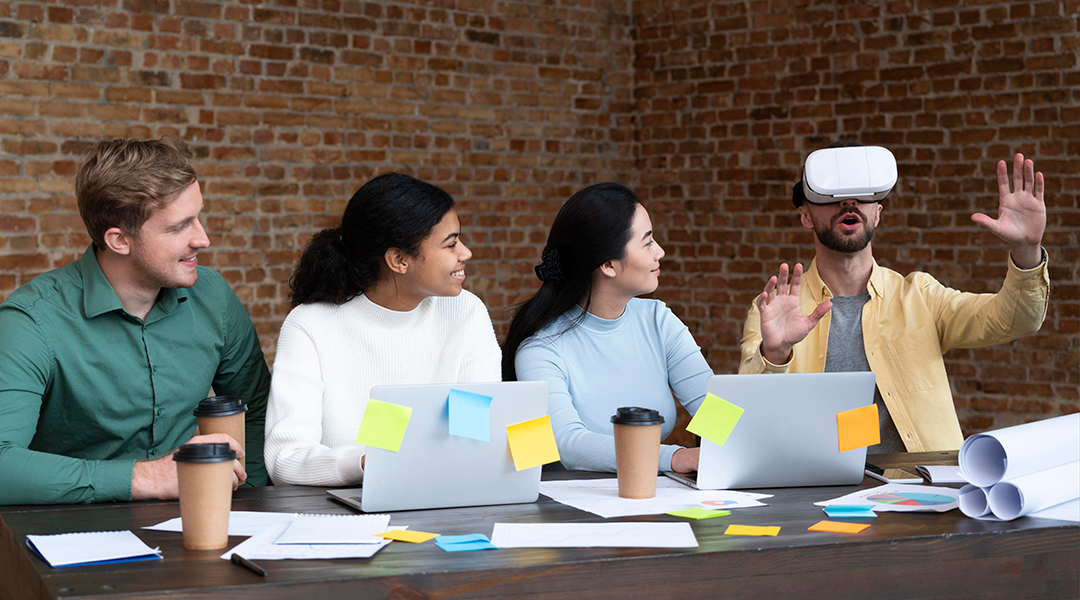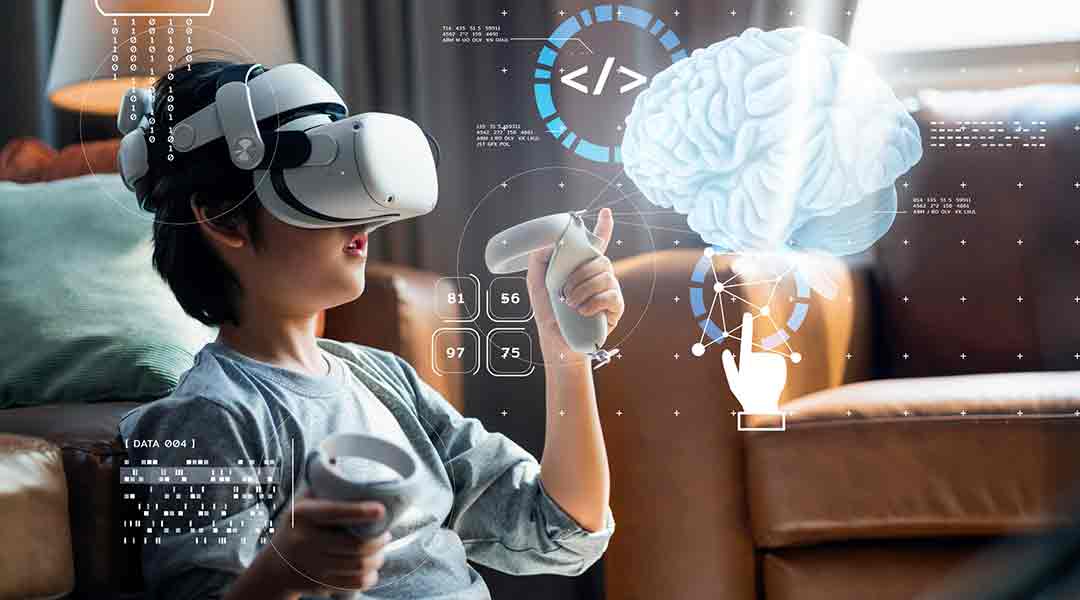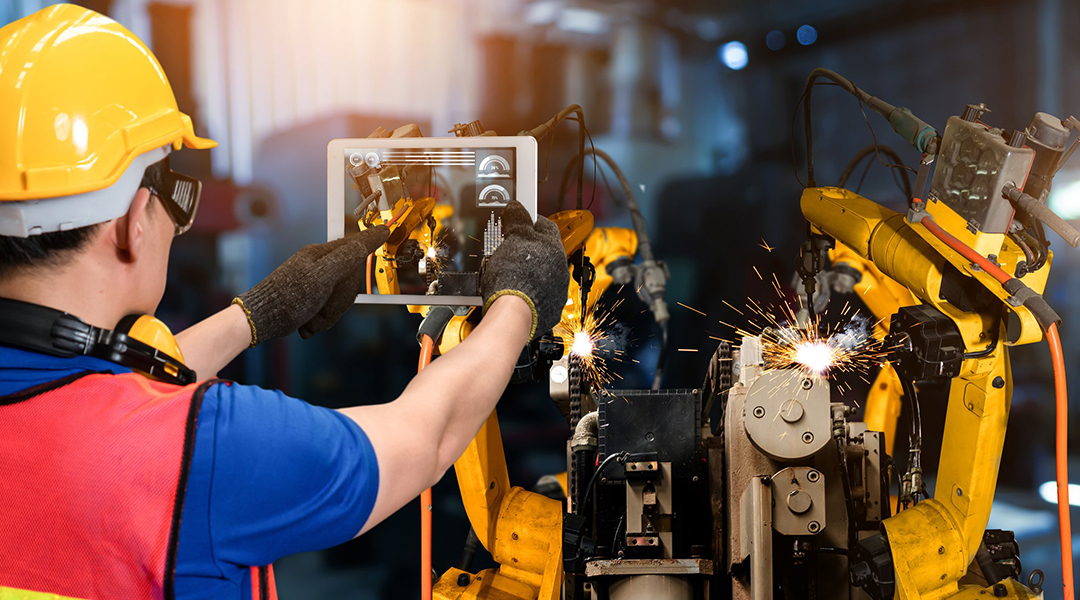With the recent organizational issues caused by the pandemic, much fewer customers are daring to venture into public spaces like clothing stores. Despite the challenges, business owners are not sitting idle. Companies that create or sell clothing are coming up with some very creative ways to maintain and grow their customer base, and implementing augmented reality fashion experiences is at the top of this list.
Augmented reality (AR), which uses software running on a mobile device and visualizes digital objects among users’ real-world surroundings, has great potential for clothing brands and stores.
It’s simply amazing what can be accomplished with augmented reality in the fashion industry, and this is exactly what we’ll be examining here. So keep reading for a closer look at AR clothing solutions and building your own with AR app development services.
How Can Companies Use Augmented Reality in Fashion?
AR in its current form (delivered via smartphone/tablet) has been around for just over a decade, and this time has allowed many companies in the clothing/fashion industry to not only grasp how AR works, but also find its strengths and best use cases. Below are the results of these experiments and real business cases of augmented reality in fashion and other similar fields.
-
Augmented Reality in Fashion Use Case #1: AR Clothing Fitting
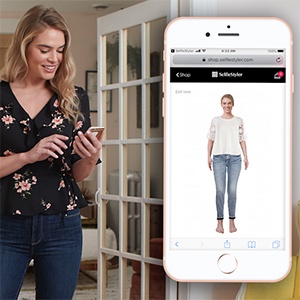
When AR clothing fitting functionality is implemented in an app, you can stand in front of a mirror or ask someone to hold your phone for you as the app visualizes how the clothes will look on your body. Obviously, you won’t be able to tell how tight/loose the clothes are in an AR changing room, but you can model dozens of unique looks in a matter of seconds. This is particularly useful for online shopping.
-
Augmented Reality in Fashion Use Case #2: AR Mirror
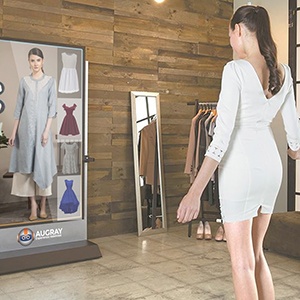
We previously mentioned that augmented reality in fashion is usually delivered through mobile apps, but this isn’t a mandatory requirement, and the AR mirror is a testament to this. The AR mirror is just a huge screen with a mirror-imitating design and highly reflective properties. It can be installed in stores and let you try on AR clothing without ever picking them up. This technology reduces the need for physical inventory in stores.
-
Augmented Reality in Fashion Use Case #3: AR Store
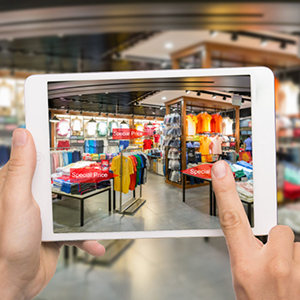
A store in augmented reality is so much better than window shopping. As you launch the app and move your phone around, you can see the store and the many items of AR clothing sold there. If you want to visit a different part/section, you can click on the corresponding interactive option. Some stores even create virtual tours that you can enjoy while sitting on your couch. Additionally, this experience often includes features like virtual fitting rooms.
-
Augmented Reality in Fashion Use Case #4: AR Clothing Showcase
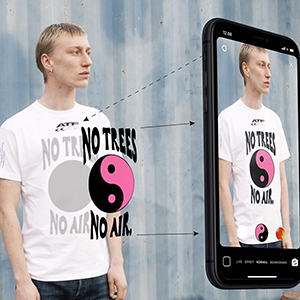
In other industries (e.g., automobile, construction), augmented reality is constantly used for presentations, promotional campaigns, and showcases. Why should it be any different for clothes? You can certainly create an AR clothing app to showcase your newest product, such as an augmented reality T-shirt. You can even create a web-based augmented reality fashion experience to make it more accessible to the public.
-
Augmented Reality in Fashion Use Case #5: AR Clothing Configurator
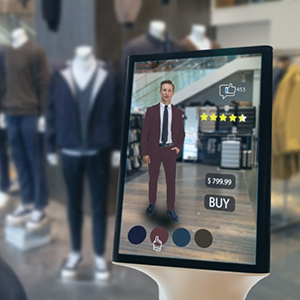
Having the option to see an item of clothes on your phone in 3D and interact with it is nice, but a configuration feature can leave an even greater impression. If you build a product configurator into your AR clothing app, you can provide customers with the opportunity to select an advanced product build. They can see the changes in real-time and “make” the clothing of their dreams. Usually, there is also an option to proceed with the purchase.
Which Brands Use Augmented Reality in Fashion?
The adoption of augmented reality in fashion is growing every year, and major brands are buying in or at least exploring how to build an AR app. Let’s examine some brands taking part in leveraging augmented reality in fashion.
-
Prada
Prada has invested in a try-on experience with some advanced features augmented reality in fashion provides. The app includes countless AR clothing items from the product catalog in different variations and models them on the body by mapping out limbs, joints, effects of gravity stretching, etc. All of this contributes to a very convenient user experience and is boosted by voice commands, so users can quickly switch between different clothes with a simple spoken sentence.
-
Macy’s
Macy’s is a major American clothing & beauty retailer that is using both virtual and augmented reality in fashion. In terms of their AR implementation, they are providing try-on experiences through different means. This includes AR mirrors in brick-and-mortar stores and a mobile app for various products worn on the head and face. This way, the AR clothing brand is hoping to strengthen customer loyalty and give clients a good reason not to flock to other competitors.
-
Carolina Herrera
Carolina Herrera is one of the most advanced augmented reality fashion brands, given that it has chosen the most accessible approach to augmented reality in fashion – letting them access it through a web browser. Their web experience features the latest clothing collection and various interactive options for customers. They can see products up close, move them around and rotate them, and even see how someone wearing the clothes would look in their local surroundings. In short, this is a sort of digital showcase brought by the capabilities of augmented reality in fashion.
-
Ralph Lauren
Ralph Lauren is another example of a clothing company using augmented reality in fashion, specifically for try-ons. However, what makes their augmented reality fashion experience unique is that the app does not require any footage of the user’s body, and does not just visualize a stand-in. Instead, users create digital avatars and model the AR clothing on the avatars.
-
The GAP
The GAP has been using augmented reality in fashion for over 4 years now, and their virtual dressing room has gotten pretty good. Their app features dozens of clothing items with size variations. The products can be modeled on a 3D mannequin, with different body shapes available to account for the diverse needs of customers. This AR clothing app should also feature checkout and order functionality at the nearest time.
Want to join these leaders?
Check out our AR development services.
What are the Benefits of Using Augmented Reality in Fashion?
If you choose to implement augmented reality in fashion your business through a personal AR clothing app, you can choose a purpose and functionality for it that’s never been created before. However, just based on the solutions available today, you can take advantage of these benefits of augmented reality in fashion:
- Allow customers to model clothing at any convenient time and place
- Increase the share of online sales and in-app sales
- Boost customer engagement with your products
- Leave an impression that solidifies your brand name
- Give customers something that competitors cannot match
- Reduce the time spent on consultation and sales processing
- Rent fewer physical stores with a shift to digital services
And this is just the tip of the iceberg of the potential of augmented reality in fashion. If you come up with a custom AR clothing solution that’s never been done before, you have the potential to become a global phenomenon!
Addressing the Challenges and Limitations of Augmented Reality in Fashion
Augmented reality in fashion offers a new horizon, but several significant challenges accompany its implementation. Understanding and addressing these challenges with effective solutions is key to leveraging augmented reality in fashion's full potential.
#1 Challenge of Augmented Reality in Fashion: Technical Challenges and User Accessibility
Augmented reality in fashion requires advanced technology, which can be expensive for retailers to implement. Additionally, not all consumers have access to AR-compatible devices, and a stable internet connection is required, which can limit the technology's reach.
Solution: Retailers should seek out cost-effective AR clothing solutions that do not compromise on quality. For broader accessibility, developing AR applications that are lightweight and can function on a range of devices, even with limited internet connectivity, can help. Retailers might also consider offering in-store AR clothing experiences for customers without access to the necessary technology at home.
#2 Challenge of Augmented Reality in Fashion: Quality and Realism of AR Experiences
For augmented reality in fashion to be effective, the virtual elements must be realistic and seamlessly integrated into the real world. Poor quality or unrealistic AR experiences can detract from user experience and damage brand reputation.
Solution: Retailers need to invest in high-quality AR technology that ensures realistic and accurate product visualization. This might involve partnerships with experienced AR developers and continuous testing to ensure the virtual elements closely match their physical counterparts in terms of color, texture, and size.
#3 Challenge of Augmented Reality in Fashion: Privacy Concerns and Data Security
Augmented reality in fashion often requires sensitive personal data, such as images and measurements, raising serious privacy concerns. Customers may be hesitant to share this information without assurance of its security.
Solution: Implementing stringent data protection measures and using secure encryption methods is essential. Retailers should also ensure compliance with global data privacy laws and be transparent with customers about how their data is being used and protected within augmented reality in fashion.
#4 Challenge of Augmented Reality in Fashion: Integration with Existing Retail Systems
Integrating AR with current retail systems and processes can be complex and disruptive. Compatibility issues between new AR solutions and existing IT infrastructure can create operational challenges.
Solution: Retailers should opt for AR clothing solutions that are flexible and can be easily integrated with existing systems. A step-by-step implementation strategy can help minimize operational disruptions. Regular training for staff to familiarize them with the new system is also crucial.
#5 Challenge of Augmented Reality in Fashion: Skepticism and Resistance to Change
Some consumers and retail employees may be skeptical or resistant to adopting augmented reality in fashion, especially if they are unfamiliar with the technology or doubt its effectiveness.
Solution: Education is key. Retailers can organize workshops, demonstrations, and interactive sessions to showcase the benefits and ease of use of augmented reality in fashion. Providing hands-on experiences and customer testimonials can also help in building trust and acceptance.
#6 Challenge of Augmented Reality in Fashion: Keeping Up with Rapid Technological Advancements
The field of augmented reality in fashion is rapidly evolving, and today's cutting-edge solutions can quickly become outdated. Staying current with technological advancements is crucial, but can be challenging.
Solution: Retailers should stay informed about the latest developments in AR technology. Forming partnerships with technology firms specializing in augmented reality in fashion can provide access to the latest updates and innovations. Allocating a budget for regular technology upgrades can also ensure the AR clothing experience remains state-of-the-art.
#7 Challenge of Augmented Reality in Fashion: Scalability and Maintenance
Effectively scaling solutions for augmented reality in fashion to accommodate a large number of products and users, and ensuring consistent performance, can be daunting. Regular maintenance is necessary to keep the system running smoothly.
Solution: Designing applications for augmented reality in fashion with scalability in mind from the outset is crucial. This includes choosing scalable cloud-based solutions and robust software architecture. Regular maintenance, including software updates and bug fixes, should be part of the operational plan to ensure ongoing reliability and performance of augmented reality in fashion.
How Does Augmented Reality in Fashion Enhance Customer Loyalty?
Augmented reality in fashion goes beyond mere novelty; it offers practical solutions to common shopping challenges while enhancing the overall customer experience. By blending the digital and physical worlds, augmented reality in fashion creates a new realm of possibilities for personalization, engagement, and interaction. Let's review the main aspects of what augmented reality in fashion contributes to customer loyalty.
1. Creating Immersive Shopping Experiences
- Augmented reality in fashion introduces a new dimension to shopping by making it an immersive, interactive adventure. This technology allows customers to experience products within realistic contexts, significantly amplifying engagement levels.
- Such immersive experiences of augmented reality in fashion cultivate a more profound emotional bond with the brand, which is a cornerstone of customer loyalty.
2. Personalization and Customization
- Augmented reality in fashion grants shoppers the power to personalize and tailor products, from clothing to accessories, aligning with their individual preferences.
- This personal involvement in product design enhances customer satisfaction and fosters a sense of ownership and connection with the brand.
- The exclusivity and uniqueness offered by AR-driven personalization serve as strong incentives for customer loyalty.
3. Enhanced Product Understanding and Confidence
- Augmented reality in fashion provides a comprehensive visualization of products, offering insights into how items look from various perspectives and in different settings.
- This enriched understanding bolsters customer confidence in their purchasing decisions, reduces return rates, and elevates overall satisfaction.
- Confident and satisfied customers are more likely to develop loyalty towards a brand and become repeat patrons.
4. Seamless Integration of Online and Offline Shopping
- Augmented reality in fashion effectively diminishes the gap between online and brick-and-mortar shopping experiences, offering a digital 'try before you buy' feature.
- This seamless integration heightens convenience and accessibility, crucial factors in nurturing customer loyalty.
- Consistent and unified augmented reality fashion experiences across various shopping platforms reinforce brand identity and loyalty.
5. Gamification and Interactive Marketing
- Augmented reality in fashion introduces elements of gamification and interactive marketing, like virtual treasure hunts or interactive catalogs, adding an element of fun to the shopping process.
- These playful and engaging activities not only enhance the shopping journey but also create memorable interactions with the brand.
- Such gamified augmented reality fashion experiences encourage frequent visits and interactions, cultivating a community of loyal customers.
6. Instant Feedback and Gratification
- Platforms designed for augmented reality in fashion offer immediate feedback and visualization, catering to the modern consumer’s preference for quick gratification.
- This immediacy can lead to impulsive purchases and positive brand associations, reinforcing customer loyalty.
- The responsive nature of augmented reality in fashion ensures high customer satisfaction, which is instrumental in building loyalty.
Augmented reality in fashion is more than just an advanced technological concept; it's a practical and influential factor in modern retail, enhancing various facets of the shopping experience. By offering immersive, personalized, and engaging interactions, augmented reality in fashion plays a pivotal role in fostering and maintaining customer loyalty. As augmented reality in fashion technology continues to advance and integrate with other emerging technologies, its influence on customer loyalty and the overall shopping experience is poised to expand even further, heralding a new era in retail.
The Future of Augmented Reality in Fashion
As we look towards the future, augmented reality in fashion is poised to break new ground, reshaping how we interact with clothing and accessories. This technological revolution holds immense potential, promising to further blur the lines between digital and physical realms in exciting and innovative ways.
#1 Future Prediction of AR in Fashion: Hyper-Personalization and Customization
In the future, augmented reality in fashion will take personalization to new heights. Consumers will be able to use AR to not only try on clothes virtually, but also customize them in real time. Imagine altering the color, pattern, or style of a garment with just a few taps on a screen. This level of customization will cater to individual preferences more accurately, leading to a more personalized shopping experience.
#2 Future Prediction of AR in Fashion: Integration with AI and Machine Learning
The fusion of AR with artificial intelligence and machine learning will lead to smarter, more intuitive shopping experiences. AI algorithms will analyze customer preferences and history, enabling AR clothing platforms to suggest styles, sizes, and outfits tailored to each individual. This integration will make fashion recommendations more precise and shopping experiences more streamlined.
#3 Future Prediction of Augmented Reality in Fashion: Enhanced Virtual Fashion Shows
AR will revolutionize fashion shows, making them more interactive and accessible. Designers can showcase their collections virtually, allowing people worldwide to attend and interact with the show in real time. This will not only democratize fashion but also open up new avenues for designers to express their creativity.
#4 Future Prediction of Augmented Reality in Fashion: Sustainable Fashion Practices
Sustainability is a growing concern in fashion, and AR can play a significant role in this area. By enabling virtual try-ons and showcasing how clothes look in various settings, augmented reality in fashion can reduce the need for physical samples and prototypes, thus lowering waste and promoting sustainable fashion practices.
#5 Future Prediction of AR in Fashion: Educational and Collaborative Opportunities
Augmented reality in fashion will also enhance educational experiences in fashion design and merchandising. Students and designers can use AR tools to experiment with designs and concepts without the need for physical materials. Additionally, it will foster collaboration across geographical boundaries, allowing designers to work together in virtual spaces.
How to Develop an AR Fashion App
Unfortunately, developing an AR clothing project is out of reach for most fashion designers, manufacturers, and retailers, simply because they don’t have the right specialists for the job. Sure, they can hire software developers or find some on-hand staff that can be educated in these ways, but both approaches are pretty demanding in terms of time and attention.
The easy solution here is to find a capable software development service provider that will take care of all your needs. For example, consider partnering with Program-Ace. We have been developing AR apps (and VR/MR solutions) since the inception of the technology, and take a diligent approach to every project.
As we develop software for different industries, we make sure to assess the companies’ business needs and ensure that the end product hits every target and draws in a wide audience. If you want to learn more about our services and get the ball rolling on cooperation on your augmented reality in fashion project, just contact us today.
